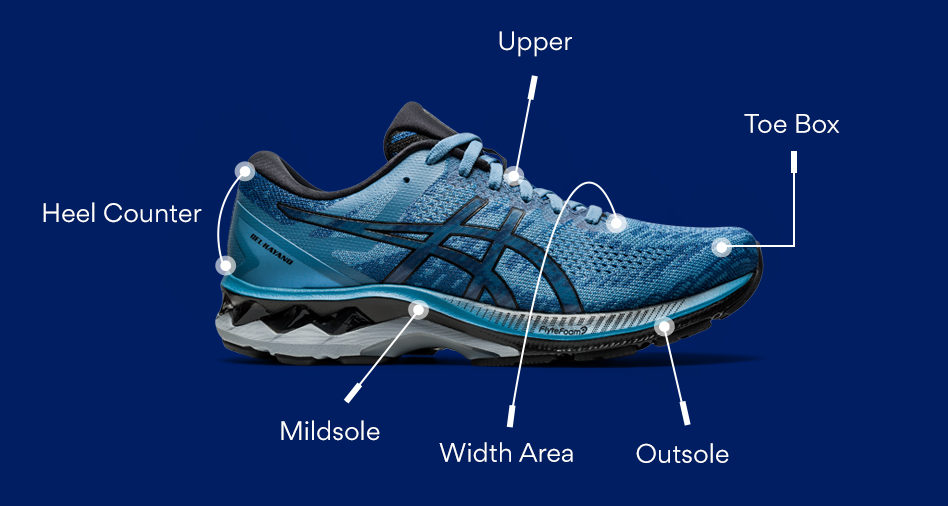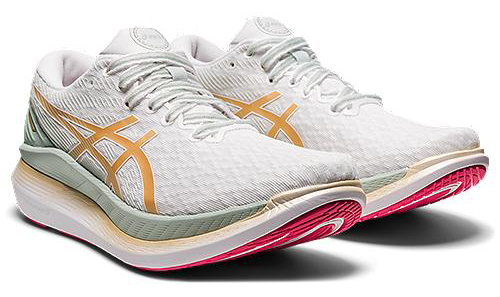What Is a Sock Liner in Shoe
Whether you are just starting or a seasoned racer, you want to run in running shoes – not just any regular athletic shoe. Why? Running shoes are specifically designed for the unique demands of running. They absorb some of the impact from your footstrike, provide varying degrees of stability, and are durable for many miles.
There are a lot of technical features to a pair of shoes, especially running shoes. These features can almost feel like their own language, so let's decode some of the common words you will encounter when choosing running shoes.

Let's start at the top: the upper
The upper is the "pretty" part of the shoe. The upper refers to the entirety of the shoe that sits on the rubber sole. The upper serves more than an aesthetic purpose; it protects the foot and keeps your shoe snugly in place. The upper may also boast single-piece construction or use hot-melt technology to replace traditional stitching for a seamless ride.
An upper may include:
- Mesh material, which allows your feet to breathe and avoids blister-causing friction
- Lacing holes, which allow you to adjust the tightness of the shoe as fits your needs. Eyelet placement impacts how the shoe will lace and a runner can decide to loosen up or lock in
- Reflective patches, which are strategically placed for optimal visibility when running
- Ventilation to prevent overheating during exercise
The toe box
As the name suggests, the toe box is the front of your shoe where your toes rest. Wider toe boxes allow more room for your toes to splay, thus reducing blister-causing friction. Some toe boxes (particularly those on trail shoes) include drainage to release water.

In shoes with rocker technology as utilized in ASICS ENERGY SAVING series, the toe box has a more pronounced arch off the ground. This design provides extra "spring" in your step during the propulsion phase.
Outsole
The outsole is the layer of foam on the bottom of your running shoe. The outsole is typically made of rubber and provides grip and traction on the road. If you plan on running on trails, you want to choose shoes with gripper rubber and lugs.
Midsole
Just above the outsole is the midsole. The midsole is a layer of foam that connects the upper to the outsole. The midsole provides the cushion of the shoe. Typically, shoes with more cushion will have a thicker midsole, while more minimal shoes will have a thinner midsole.
In recent years, many innovations in running shoe technology have involved the midsole. The new foam provides a cushion without adding extra weight to the shoe. For example, ASICS uses FLYTEFOAM™ technology for lightweight, springy cushioning.
If you use a stability shoe, the midsole also contains motion-control features. Arch support and extra cushioning on the midsole offset excessive pronation (here's how to know if that is you).
Heel counter and heel drop
As you continue to move toward the back of the shoe you reach the heel counter. In many kinds of running shoes, including ASICS, this is an exoskeleton that wraps around the outside of the heel. It's often made of rigid material which holds up against the impact that area of the foot experiences when running. It helps the shoe keeps its shape and stabilizes integrity.
The heel drop is the measurement of the difference between the height of the heel and the height of the forefoot (toe). Heel drop is typically measured in millimeters. For example, a shoe with a 24mm heel height and a 15 mm forefoot height has a heel drop of 9mm.
A higher toe drop (≥10mm) provides more arch support. These work best for runners with Achilles issues or who need more arch support. Moderate heel drops (5-9mm) are becoming more popular, as they provide some arch support and a lightweight feel. Runners who desire a very lightweight shoe and do not need any arch support may opt for low heel drop (<4mm) or zero drop shoes.
Support
Running shoes come with two types of support: neutral and stability. The difference comes from the midsoles; stability shoes will have extra cushion and arch support built-in. Most runners are fine using neutral shoes. If you overpronate or have a background of specific injuries, you may choose a stability shoe. Some runners with mild pronation choose a neutral shoe but add an orthotic insert.
Cushion
Cushioning is the amount of thickness in the midsole. Running shoes range from lightweight to maximum cushioning. The amount of cushioning translates to how much support you will have.
- Lightweight: minimal cushion, you can feel the ground
- Moderate: Some support, but not too heavy
- Maximum: a plush "pillow" feel under your feet
Cushioning can be plush or firm, depending on the type of foam used. You can mix and match the type of cushioning and the degree of cushioning. Lightweight shoes can have plush cushioning, maximum shoes can have firm cushioning, and vice versa.
Your choice of cushioning depends on your individual needs and the purpose of the shoe. Typically, a daily trainer provides more cushion. For workouts and races, many runners opt for lightweight shoes.
The extras
Carbon Plates: Carbon plates serve as propulsion boosts to improve running economy and speed. You may notice more racing shoes utilizing carbon plates, such as ASICS METASPEED™ Sky. Carbon plates do stress the calves and feet more, so they are not ideal as an everyday training shoe. You are best to save these for a few peak workouts and your races.
Lugs: On trail running shoes, lug line the outsole to provide traction on unstable surfaces. The longer the lug, the more traction the shoe provides on dirt surfaces.
Rocker: On some new shoes (such as the ASICS GlideRide or Metaracer), the outsole and midsole feature a pronounced curved sole. This curved sole is called the rocker, which can help you run faster with less fatigue. The rocker reduces ankle flexion and improves shock absorption so that your leg muscles feel less fatigued when running. These features are typically common in new racing shoes, although they are appearing more in some daily trainers.
Tongue: Different brands use the tongue to offer new benefits, too. If you see that a shoe has a mono-sock fit, it's likely that the tongue is built into the upper and the whole thing fits more like a sock. This prevents any movement or distraction from a tongue that slips or moves. Trail shoe tongues are often stitched to protect against picking up gravel or feature a "lace garage" to hold loose laces and prevent tripping.
Stockliner: The sockliner lives inside the shoe and gets up close and personal with your feet. Technology in the sock liner can be moisture-wicking or made of memory foam. ASICS uses ComforDry material that cushions, breathes to manage moisture, and is anti-microbial. While this part can make the first feel of a shoe great, sockliners are also removable to accommodate orthotics.
We hope taking this lap with us helped to de-mystify at least a few layers of sneaker construction. Check out the cheat sheet below and don't be shy about asking questions next time you're shopping. Better yet, or throw some into the Runkeeper Running Group on Facebook — we're sure you won't be the only one still wondering!
If you're still looking to learn more about shoes, we've written this guide on pronation.
Source: https://runkeeper.com/cms/start-running/anatomy-of-a-running-shoe-heres-what-all-those-technical-terms-actually-mean/
0 Response to "What Is a Sock Liner in Shoe"
ارسال یک نظر